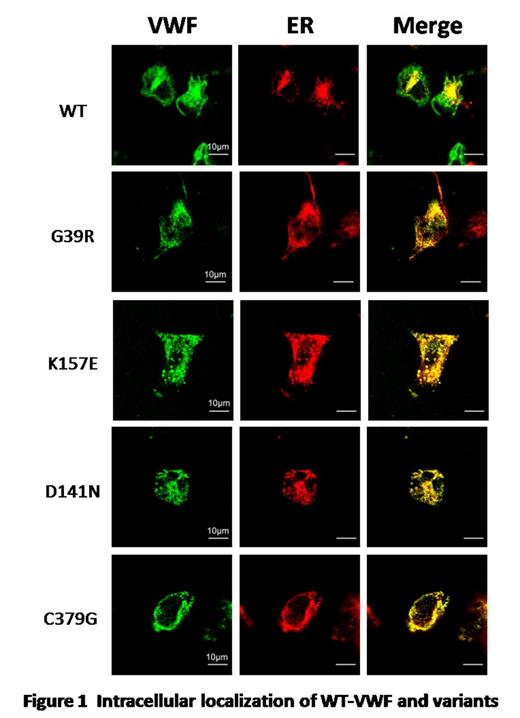Abstract
Gene mutations play an important role in the pathogenesis of von Willebrand disease (VWD), resulting in the qualitative defect or quantitative deficit of von Willebrand factor (VWF). VWF propeptide is composed of D1 and D2 domain, which acts as a covalent oxidoreductase in the multimerization. In addition, the propeptide is necessary for the transport from endoplasmic reticulum (ER) to Golgi-apparatus, basal secretion and regulated secretion of VWF. However, the mechanisms of the mutation in D1 domain impairing VWF multimerization and causing low VWF levels in patients remain unknown. Herein we identified four mutations in the D1 domain from VWD patients, and assessed the effect of these mutations on the function of propeptide.
We identified p.G39R, p.D141N, p.K157E, and p.C379G in three VWD patients. To characterize the roles of four mutations in propeptide-depend multimerization, we generated several truncated-VWFs, D1D2D¡¯D3 (residues 1-1241), including G39R, K157E, D141N, C379G and wide type (WT). These constructs were then expressed in HEK 293 cells, and were evaluated the D¡¯D3-dimer formation of mutations and WT. Full-length VWF comprising mutations and WT were also restructured and were transfected in HEK 293 cells. We then analyzed the VWF multimer distribution and VWF antigen in the cell supernatant and cell lysate. We also assessed VWF retention in ER and the stimulation secretion by phorbol-12-myristate-13- acetate (PMA) of mutations and those of WT.
Two type 3 and 1 type 1 patients were enrolled in our study. VWF antigen were 3, 1 and 8 IU/dL, and VWF:Rco were 2.1, 2.3 and 5.6 IU/dL respectively in three patients. VWF multimer distribution exhibited none in two type 3 patients and normal-like multimer pattern in the type 1. Sequence analysis of VWF gene showed two heterozygous mutations (p.G39R and D141N) in D1 domain of one type 3 patient, and a heterozygous K157E in propeptide and a heterozygous C1165R in D3 domain of the other patient with type 3. Type 1 patients had a heterozygous C379G mutation. Among these four mutations in D1 domain, p.G39R, p.K157E, and p.C379G were novel.
In the supernatant of transfected cell, dimerization of D¡¯D3 was absent in truncated-G39R. Compared with that of truncated-WT, decreased but detectable dimerizations were detected in K157E, D141N, and C379G. Similar results were also observed in multimerization of full-length constructs. The multimer assembly was too low to visualize in G39R, whereas decreased medium and absent large VWF multimers were seen in K157E, D141N, and C379G.
By immunofluorescence imaging, all full-length VWF variants were detained in ER in different degrees (fig 1). The basal secretions of G39R, K157E, D141N, and C379G were (2.7¡À0. 3)%, (2.5¡À0.2)%, (26.0¡À4.1)%, and (22.4¡À3.8)% of WT respectively. However, VWF antigens in the lysate of transfected cells were (116.5¡À5.4)%, (90.9¡À3.0)%, (91.7¡À0.4)% and (113.8¡À2.9)% of WT for G39R, K157E, D141N, and C379G. No detectable secretion increases of mutant VWF induced by PMA were observed in the transfected cells, while WT-VWF with PMA exhibited increased secretion from 0.69% to 1.66%.
These four mutations in D1 domain downgraded the activity of propeptide as the covalent oxidoreductase, and impaired the muiltimeriztion induced by propeptide. They also interfered with VWF transport from ER to Golgi-apparatus and caused the VWF retentions in ER. Therefore, they further reduced the basal secretion and regulated secretion of mature VWF, which could explain the possible pathogenesis of quantitative deficit of VWF in VWD.
No relevant conflicts of interest to declare.
Author notes
Asterisk with author names denotes non-ASH members.


This feature is available to Subscribers Only
Sign In or Create an Account Close Modal